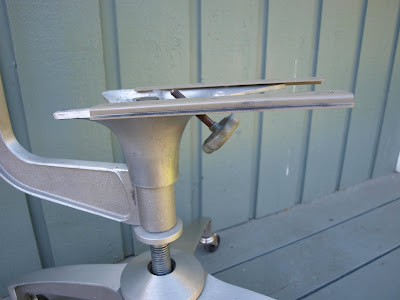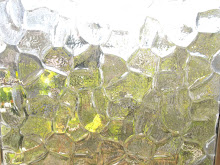
I found this great old office chair at Goodwill yesterday for $10 (it had a coarse gray upholstered seat and back which I immediately disassembled upon getting home). It's probably 1950's or 1960's, made back when things had metal parts instead of the black plastic prevalent now. I turned over all the chairs that had swivel bases and examined their parts for aesthetic appeal and for whether they'd suit my project, and this one won hands down. The modern office chairs have very large, clunky mechanisms where the support meets the seat that handle raising and lowering the seat, tilting the chair back and swiveling all in one. They're bulky, ugly, have arms projecting on all sides, and are made of unattractive metal or plastic meant to be unseen, like the black-clad stage hands in a play - although they do the job well. I liked this chair because of the simplicity of its mechanisms, because I'm a sucker for anything that's cast metal (this is brass), and because the finish is brushed stainless. And who doesn't love brushed stainless? Am I right?

The height of the seat is raised and lowered by turning the bottom disc, through which the threaded post moves. The disc is attached to the base with the legs and casters. There is a catch (the little nub in the middle of the unthreaded track on the post) that serves as a barrier for both this mechanism and the disc above, which sets a height for the chair back to brace against. The top disc also threads on the post, but it moves up and down independent of anything else.

The disc can be lowered.

And then the chair back.
The seat mounts on 2 steel strips that bolt or screw to its underside and then slide back and forth on the base to determine how far forward or back you want to sit in relation to the chair back (I don't think I've ever used a modern chair that does this, but maybe I just couldn't figure out their inner workings). There doesn't seem to be any guard to keep the seat from sliding off the base, but there is a simple set screw (with the enlarged knob handle) that braces against the seat bottom to keep it from self-adjusting.

The last mechanism is a simple tilt built into where the chair base secures to the back that responds to the angle at which you lean within a small range of motion.

I think re-using this old chair base for what God intended it to be is going to be a lot easier than trying to hack something together from plumbing parts and old pipe and whatever else I can find at the hardware store. What I really need is either a forge and machine shop or a hardware store that stocks all the weird and over-specialized bits of hardware that no one would ever have any reason to use outside of an industrial production setting. It would be entirely unprofitable, but what a cool place to go and poke around and try to figure out what things do. It would have to be bulging at the seams, poorly lit, with tight, claustrophobic spaces - basically an even more convoluted annex of Hardwick's. If you ever find a place like this, please let me know.


16 comments:
Nice articles and your information valuable and good articles thank for the sharing information chair base
Nice articles and your information valuable and good articles thank for the sharing information Back Support for Office Chair
The office chair is very sturdy, and I love how it adjusts to my needs. I can sit for hours without any discomfort.
Cool
Plastic chairs are a popular choice in modern office spaces due to their affordability, versatility, and easy maintenance. They come in a variety of designs and colors, allowing them to fit seamlessly into different office aesthetics. Lightweight and durable, plastic chairs are ideal for both collaborative spaces and individual workstations. Additionally, many are designed with ergonomic features to support comfort throughout the workday. While they may not always offer the same level of luxury as more traditional seating options, plastic chairs offer practical solutions for creating functional and stylish work environments.
https://vbonchairs.com/
Adjustable chairs are key to all-day comfort, letting you customize height, tilt, and support to fit your body. They help reduce fatigue, improve posture, and keep you feeling good from your first meeting to your last.
Nice articles and your information valuable and good articles thank for the sharing information office chairs
Great tips from Diya Seating Solution! Regular maintenance keeps office chairs comfortable, durable, and functional for long-term use. Very helpful advice!
https://www.diyaseatingsolutions.in/
Nice articles and your information valuable and good articles thank for the sharing information Work chair
This blog explains perfectly why investing in a quality Office chairs is essential for health and efficiency. Posture, comfort, and durability all matter when working long hours. If you’re searching for ergonomic, stylish, and affordable office chairs online, Vibecrafts is the best destination.
Anti-skid feet may seem minor, but they’re essential for stability and safety. They protect floors, prevent unwanted movement, and enhance user comfort in every seating environment.
https://chairpartsmanufacture.com/
I recently explored the beautiful chairs collection from VibeCrafts, and I’m really impressed! Their chairs are stylish, comfortable, and perfectly crafted for both homes and offices. Whether you need dining chairs, lounge chairs, or accent pieces, VibeCrafts has designs that truly elevate any space. Highly recommend checking them out!
“Can I buy replacement casters that work on both carpet and wooden floors?”
https://chairpartsmanufacture.com/
I recently checked out VibeCrafts’ office chairs collection, and it’s impressive! Their chairs combine comfort, style, and durability — perfect for long work hours. If you’re planning to buy ergonomic office chairs online in India, VibeCrafts has some amazing options that elevate both productivity and workspace aesthetics.
Useful for dealers looking for chair suppliers near them, with clear guidance on selecting trustworthy manufacturers and understanding wholesale sourcing advantages.
https://diyaseatingsolutions.com/
Useful guide for office-chair spare parts wholesalers. Clearly explains component demand, quality benchmarks, and sourcing considerations, helping wholesalers manage inventory efficiently and meet market requirements with confidence.
Post a Comment